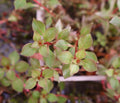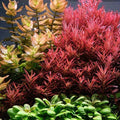10 Useful Aquascaping Tips
There are certain considerations to make when switching from normal fishkeeping to aquascaping. Keeping an aquarium at home is just one aspect of the art form known as aquascaping.
Beginners sometimes feel overwhelmed by the additional planted aquarium knowledge they must read when they first start aquascaping. In order to aid newcomers and ease their transition into the aquascaping world, we've put up 10 useful aquascaping tips.
10 Useful Aquascaping Tips
1. Learn About Your Aquatic Fish and Plants
Today, more than 200 aquatic plants have been found. You just need to study a select number of them, not all of them. those that will probably be applied in a planted aquarium.
Some of the most common aquatic plants used in aquascaping are aquatic mosses including Weeping moss, Java moss, Peacock moss, and Stringy moss, as well as Fissidens fontanus, Riccia sp. Dwarf, Bucephalandra sp., Hemianthus callitrichoides Cuba, and Eleocharis sp. mini. So, you need to start there.
2. Learn More About the Aquarium's Water Chemistry and Parameters.
Don't strive to become a scientist here, but gaining a basic understanding of the chemistry of the water in your aquarium will be beneficial in the long term.
The key water chemistry and parameter information to keep in mind is as follows:
Nitrogen Substances
Nitrate, nitrite, and ammonia are the three major substances to be measured. All three have a significant impact on the nitrogen cycle, often known as "cycling" your aquarium.
Nitrifying bacteria break down aquarium waste, including uneaten food, fish feces, and decaying plant leaves, to produce ammonia (NH3). Ammonia should never be found once the aquarium has completed its cycle.
The end result of the second step of the nitrogen cycle is nitrite (NO2). The Nitrosomonas bacteria aid in the breakdown of ammonia into nitrites. Make sure you don't receive numbers greater than 0 ppm since even a measurement of 0.5 ppm might be damaging to your fish, even if it's not as deadly as ammonia.
The third and final step of your aquarium's cycle process is nitrate (NO3). Nitrobacter and Nitrospira are bacteria that convert nitrites to nitrates.
3. Learn the basics of aquascaping design, such as the Golden Ratio, Focal Points, the Rule of Thirds, and Contrast.
Aquascaping may be a type of art where imagination and originality are crucial, but if you want to succeed, you must understand the fundamentals of this method. Aquascaping is no different from nature in that it places a high value on measurement.
Your tank should not only be pleasing to the eye but also pique its curiosity in the proper ways. You want your plants to thrive to their greatest potential and your fish to feel at ease.
By adhering to a set of purely mathematical principles, you can do all of that. Nature is mathematical before it is beautiful, surprising, and varied.
4. Study the Aquascaping Gurus
In both our personal and professional lives, we all have heroes. They motivate and encourage us to pursue our passion.
Without a doubt, Takashi Amano is the finest expert in the field of aquascaping. Amano, who founded the Nature Aquarium, was a great innovator in the aquascaping industry.
He built some of the best planted aquariums the world has ever seen with a real, intrinsic love for Japanese perfection.
Florestas Submersas, a huge natural aquarium in the shape of a U that can be seen in Portugal's Oceanário de Lisboa, is his most well-known piece and a true testament to his skill and vision.
5. Don't let aquarium algae deter you.
Aquarium algae are a particular kind of aquatic organism that can do photosynthesis. To put it simply, they should naturally exist in your planted aquarium.
We all went through the torture of trying to figure out what went wrong with our planted aquarium, but it had to happen sooner or later.
Instead of being furious and quitting aquascaping entirely, try to identify the primary causes of algae development in your planted aquarium and the best techniques to avoid it.
6. First, draft your aquascape on paper.
Similar to how an architect initially draws out plans before putting out a home, you should approach aquascaping in the same way.
The nicest part about drawing your next aquascape is that you may make as many errors as you want, and they can all be fixed with an eraser.
instead of planning your hardscape before you decide to switch out one stone for another and disturb the aquasoil.
Therefore, before going to your aquarium, take a piece of paper and a pencil and begin drawing your next aquascape design.
7. Avoid stuffing your planted aquarium too full.
Always make the aquatic plants in aquascaping your main priority rather than the fish.
Additionally, it is usually preferable to have more plants than fish when starting a new aquascape, particularly long-stemmed plants, since they develop more quickly and will aid in collecting additional nutrients from the water.
If you have too many plants in your aquarium, the nitrites and nitrates in the water will rise, making the perfect conditions for algae blooms.
8. Participate in online forums and workshops on aquascaping.
Go online and search Google for blogs and websites related to aquascaping. You'll discover a lot.
Visit forums about aquascaping and participate in the discussion. Numerous beginners and more seasoned aquascapers may both be found there. There is a lot to discover.
9. Find inspiration from your neighborhood aquascaping store.
Many stores that specialize in aquascaping have their own natural aquarium exhibits. Plan your trip now to witness the live inspiration.
While you're there, ask the store personnel for suggestions on how to set up your own aquascaping, how to deal with algae issues, and how to use technical equipment.
Make a shopping list and calculate the cost of constructing your first natural aquarium or upgrading the aquarium you currently own.
10. When taking photographs of aquariums, avoid using the built-in flash.
Keep in mind to avoid using your camera's built-in flash while shooting pictures of your planted aquarium.
You will capture reflections in your photos if your flash is pointed directly at your aquarium. Utilizing an external flash unit that you can set to fire from the top of your planted aquarium is thus preferable.
















